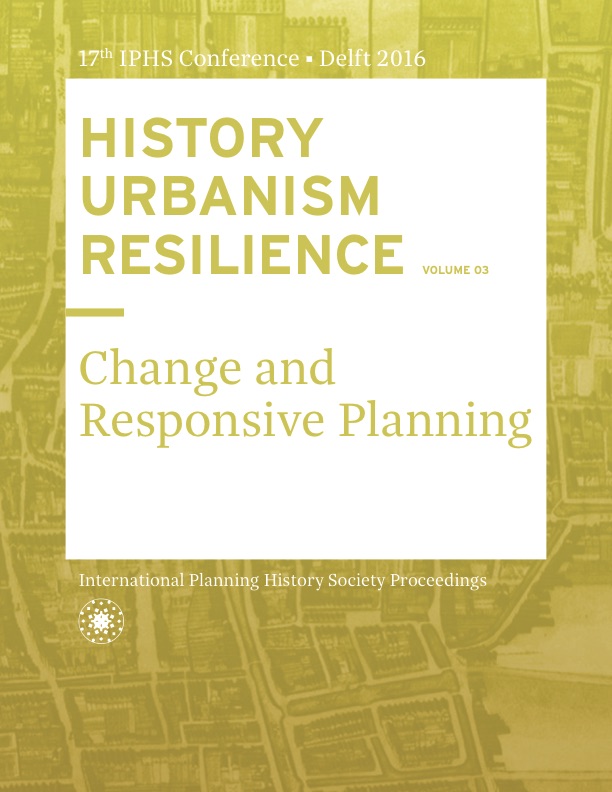The transformation and influence of overseas commerce of Mingzhou port-city in Tang and Song Dynasties(821-1279)——Concentrated on the historical relics
DOI:
https://doi.org/10.7480/iphs.2016.3.1254Abstract
Known as Mingzhou in the Tang and Song Dynasties, Ningbo was one of the largest port-cities in ancient China. As a local city that combined both port and waterside characteristics, the urban planning was not only limited by its waterside property, but also guided by the development of port trade. At the same time, it possessed the flexibility of a local city beyond the ancient capital under the central system. Furthermore, the most typical feature of Ningbo lied in the characteristic of being a port-city among the three points mentioned above.Ningbo was one of ancient China’s rare cities characterized by being open to overseas commerce. Through overseas commerce acting as the main goal and developmental motivation, its urban planning distinguished itself from that of most political and military type cities. Research on the changes to urban planning under Ningbo’s economic and political competitions can supplement case studies of China’s ancient urban planning. Additionally, it can provide a reference for research on urban planning of ancient port cities around the world.
Overseas commerce of ancient Ningbo was developed since the late Tang Dynasty, and reached its peak in the Song and Yuan Dynasties. Later it transformed into domestic commerce due to a ban on maritime trade in Ming and Qing dynasties. This thesis takes historical relics as the breakthrough point to research the transformation of overseas commerce in Mingzhou port-city from the Tang to the Song Dynasty, and on this basis, to discuss the effect on the city. The author considers the overseas commerce as characteristics of Mingzhou port-city that influenced its planning management system, spatial pattern, and its form of open concept.
By comparing the historical relics and archaeological information of “Heyi Gate-Yupu Gate District” and “Dongdu Gate-Lingqiao Gate District”, which are the port areas of the Tang and Song dynasties respectively, this thesis explains that the core port region in Mingzhou shifted from Tang to Song Dynasty. Additionally, the port’s function transformed from that of a single port to that of a comprehensive port. This shift reflects a process in which management of overseas-related institutions in the sub-city scaled up and spilled over, then completely separated.
Finally, the author suggests that a function of the port-city was it transformed the port region into the earliest street market, which caused the relaxation and disintegration of the "system of workshops and stores"; the nature of a port-city established an asymmetric spatial pattern in which “the western city is residential and the eastern city is commercial”; the orientation of the port-city gives birth to a “window” of overseas commerce and the city’s open culture.
References
Dong J. H. Study on the history and theory of city planning. Shanghai: Tongji University Press,1999.
Liu H. W., Wang L. J. “Formation of Ningbo port-city and development of the foreign maritime route.” In Ningbo and the maritime Silk Road, edited by Ningbo Institute of cultural relics and Archaeology,123-132. Beijing: Science Press, 2005.
Lin S. M. To reproduce the old civilization——the archaeological research of the eastern port Ningbo. Shanghai: Shanghai Sanlian Bookstore, 2005.
Lin S. M. Transformation of Sanjiang: history research of the city development of Ningbo. Ningbo: Ningbo Publishing House, 2002.
Lin S. M. “Ningbo Heyi Road excavation site Report in Zhejiang Province. ”, Oriental Museum, Janauary 5,1997.
Luo R (Song Dynasty). Baoqin Siming Zhi. Taipei: Chengwen Press,1983.
Lin S. M..Ming Zhou, as a famous port of the maritime Silk Road. Beijing: Ocean Press, 1990.
Liu H. W. Foreign cultural exchanges of ancient Ningbo: centered on the historical and cultural relics. Beijing: Ocean Press, 2009.
Lin J. Y. Old story of Ningbo. Ningbo:Ningbo Publishing House, 2008.
Wang R. C., Kong W. The history of Ningbo City. Ningbo:Ningbo Press, 2010.
Wang R. C., Kong W. Research of the history of Ningbo City. Ningbo:Ningbo Press, 2010.
Xu M. G. “Verification for the forming time and the exact site of Mingzhou Port in Tang Dynasty. ”Zhedong culture, (2001):172-180.
Yu H. X. “The main culture of Ningbo: culture of Maritime Silk Road.” Ningbo Daily, February 2,1999.
Yang K. Study on the system history of the capital in ancient China. Shanghai:Sanghai people’s Publishing House, 2003.
(Japan) Y.Shiba. Chinese urban history. Beijing: Peking University press, 2013
Zhou S. F..Research on the Ningbo old city. Ningbo: Ningbo Press, 2008:113.
Zhe F. Old Pictures of Ningbo(atlas). Ningbo: Ningbo Publishing House, 2004.

